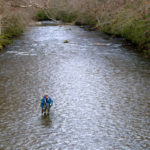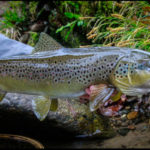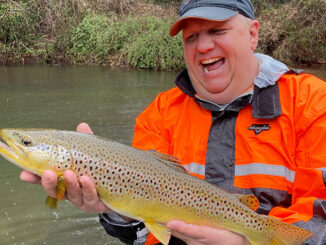
Flies that imitate fish are the ticket in some instances
Thunderstorms and showers are as much a part of late summer as huckleberries, fireflies and bobwhites. Although summer storms arrive quickly and usually end just as quickly, even high-gradient mountain streams need a little time to calm down.
When water is high and slightly dingy, it’s pointless to try to float a dry fly or nymph unless you just like to see how fast your fly moves in swift water. This is the time to break out the streamers, the draft horses of fly fishing.
While dry flies and nymphs work by sight, streamers work by sound. The size and bulk of a streamer cause it to vibrate when it’s stripped through the water, making it easier for a trout to find.
Another advantage of streamers is that they attract bigger trout, especially lunker brown trout. As browns increase in size, they rely less and less on insects and more on forage fish for sustenance. Big browns prefer a feast, not a snack. Streamers are designed to simulate typical forage fish such as dace, darters, chubs, sculpins, shiners, small fish and other aquatic life found in mountain streams.
Although streamers come in a variety of sizes, patterns and colors, the four basic types are muddlers, hackle wings, bucktails and zonkers. Muddlers usually have large heads designed of clipped deer hair. Hackle wings have wings of long hackle feathers. Bucktails have wings made of deer hair and other animal hair or, more commonly now, synthetics. Zonkers have a strip of soft fur tied along the top of a hook.
Other streamers, especially brightly colored ones, serve as attractors, and while they are easier to see in murky water, they don’t get as many productive strikes as forage fish imitations.
The most-productive way to work a streamer is to try to match the actions of the aquatic life the streamer imitates. A shiner imitation, for example, will simulate the darting actions of a real shiner when the streamer is stripped in 4- to 6-inch pulls across a current. When using a sculpin pattern, strip the line in 4-inch pulls and let the fly drop to the bottom and sit for a few seconds before resuming the retrieve.
Work in current
Under most conditions, cast upstream, give the line time to sink, and begin the retrieve, using short jerks alternated with long, steady pulls. Try to place the streamer close to overhung or grassy banks, places where big trout tend to lurk. Let the stream work for you by keeping the streamer in the current and letting it sweep and swirl naturally. In flat water, twitch the streamer across the surface to simulate a struggling insect or minnow. When fishing near obstructions such as logs or large rocks, let the streamer wave in the current for a few seconds before casting to another spot.
Streamers can be fished with floating or sinking lines, and weight can be added to get the streamer down into deep pools. The added weight causes the streamer to dip between jerks, giving the fly an erratic motion that suggests an injured minnow, something a big brown will find hard to resist.
A major advantage of using a streamer is that presentation is not as crucial as it is in dry-fly fishing. Detecting a strike is much easier with a streamer. Also, when a trout hits a streamer, the large hook — anywhere from size 1/0 to 10 — usually will hold the fish. Make sure you have a tippet strong enough to accommodate the extra load.
Suggested patterns for mountain streams include: Woolly Bugger, Sculpzilla, Micky Finn, Muddler Minnow, Black Nose Dace, Hornberg, Spruce Fly and trout imitations.
Fly shops usually have a variety of streamers in a variety of colors and sizes, some that imitate real aquatic life and others that don’t seem to imitate anything. Stick with the basics and save your money.







Be the first to comment